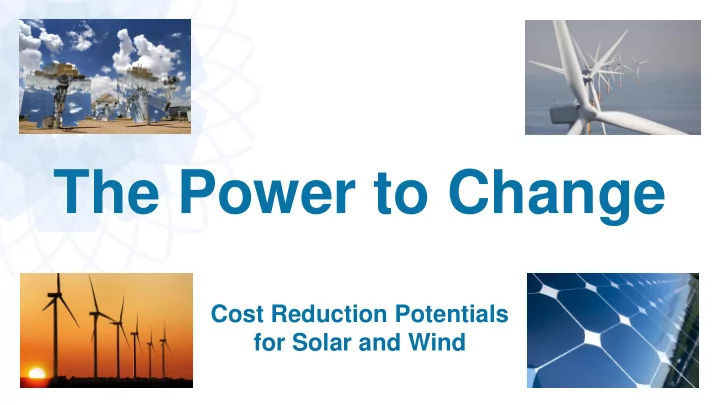

The Power to Change Cost Reduction Potentials for Solar and Wind 1
Continued cost reductions are vital To rapidly meet economic, environmental and social policy goals Accelerating deployment is crucial to keeping open ambitious climate targets Markets need to be broadened and deepened Focus will shift sooner rather than later from competiveness to costs of transition 2
Methodology - c-Si - CdTe 100.00 22% price reduction for each 22% price reduction for each 22% price reduction for each 22% price reduction for each doubling of cumulative volume doubling of cumulative volume doubling of cumulative volume doubling of cumulative volume Global average module selling price (2015 USD/W) 1992 2006 c-Si price increase 2006 c-Si price increase 2006 c-Si price increase 2006 c-Si price increase due to polysilicon shortage due to polysilicon shortage due to polysilicon shortage due to polysilicon shortage Top-down learning curve analysis 10.00 1998 2002 2004 2011 1.00 2014 2025 0.10 1 10 100 1000 10000 100000 1000000 Cumulative production volume (MW) Detailed bottom-up technology-based analysis Approaches complement and inform each other 3
Cost reduction potentials to 2025 Global weighted average data Investment costs Percent Capacity factor Percent LCOE Percent (USD/kW) change change (USD/kWh) change 2015 2025 2015 2025 2015 2025 5 1 Solar PV 1820 830 -57% 18% 18% 0.13 0.06 -64% CSP 5 550 3 700 -33% 41% 45% 8.4% 0.15 -0.19 0.09 -0.12 -37% (PTC) CSP (ST) 5 700 3 600 -37% 46% 49% 7.6% 0.15 -0.19 0.08 -0.11 -43% Onshore 1 560 1 370 -12% 27% 30% 11% 0.07 0.05 -26% wind Offshore 4650 3950 -15%? 43% 45% 5% 0.18? 0.12 -33% wind 4
Costs will continue to fall for solar and wind power technologies to 2025 Large cost differentials Continued technology innovation Growing scale of markets Policy framework critical to unlocking largest savings
New renewable power technologies: rapidly maturing
SOLAR PHOTOVOLTAICS 7
Solar PV: Installed system costs to 2025 Large average cost reduction potential BoS dominates potential Will require action by policy makers
Solar PV LCOE to 2025 Highly dependent on BoS convergence scenario
ONSHORE WIND 10
Onshore wind Historically every doubling of global capacity has Technology innovation Increase meant: Capacity Hub Height Decrease (for same 8% decline in investment costs Rotor diameter Specific kW costs wind resource) Yield (for same wind resource) 12% decline in LCOE
Onshore wind costs Capacity factor drives cost reduction potential -26% for global LCOE Transition to today’s best technology and new Main driver - CF growth
OFFSHORE WIND 13
2000 to 2015 a shift to deeper waters further offshore 14
Offshore wind: Installed costs There are incremental opportunities to reduce capital costs by 2025 across the entire wind farm, from interconnection to project development Inst. Reduction driven by: 2015-2025 costs ▪ construction and installation Installed (about 60% of total cost Cost Reduction reduction potential) About 15% Other ▪ Incremental cost reductions for turbine rotors and nacelles Projected installed cost reductions for offshore wind, 2015 to 2025
Offshore wind: LCOE WACC ▪ Reduced cost of capital (larger pool of experienced developers, maturity of local markets, decreased perceived risks. Larger ▪ shift from large 6 MW turbines to very large (8 MW+) Turbines ▪ blade and drivetrain improvements Increased capacity factors Lower downtime Lower O&M Costs Costs fall by one-third
CONCENTRATING SOLAR POWER 17
Concentrating solar power Deployment in its infancy! CAPEX could decline by one-third by 2025 PT -31% CAPEX (15-25) ▪ USD 5550/kW to USD 3800/kW 2025 ST -35% CAPEX (15-25) ▪ USD 5450/kW to USD 3600/kW Indirect EPC costs + Owner’s costs also major contributors to reduction potential Plant Efficiency: 15% Plant Efficiency: 15.5% currently to 18% by 2025 currently to 17% by 2025
Concentrating solar power By 2025 the LCOE of both parabolic through and solar tower technologies will decrease between 37% and 43% Main Lower capital drivers investment costs Higher efficiency Reduced WACC
Cost reduction drivers are changing Low equipment costs change the dynamics Balance of project costs, O&M, financing will grow in importance In some cases more challenging to unlock and integration issues need to be anticipated But cost differentials are large and the policy levers exist
Cost reductions to continue The winners are customers, the environment and our future www.irena.org mtaylor@irena.org
Recommend
More recommend